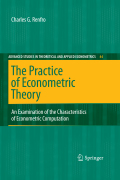
Econometric theory, as presented in textbooks and the econometric literature generally, is a somewhat disparate collection of findings. It is essential nature is to be a set of demonstrated results that increase over time, each logically based on a specific set of axioms or assumptions, yet at every moment, rather than a finished work, these inevitably form an incomplete body of knowledge. The practice of econometric theory consists of selecting from, applying, and evaluating, this literature, so as to test its applicability and range. Thecreation, development, and use of computer software has led applied economic research into a new age. This book describes the history of econometric computation from 1950 to the present day, based upon an interactive survey involvingthe collaboration of the many econometricians who have designed and developedthis software. It identifies each of the econometric software packages that are made available to and used by economists and econometricians worldwide. Offers a complete overview over all econometric software packages available worldwide Based on an interactive survey of the econometricians who have developed the software Presents the history of the development of econometric computation since the 1950s Gives practical advice as to how to use econometric softwarein applied economic research INDICE: Econometric Computation.- Econometric Software: Characteristics, Users, and Developers.- Econometric Diagnostic Tests.- The Basic Statistics.- The Failure of Assumptions.- Cointegration and Alternative Specifications.- Several Historical Considerations.- The Implications of the Findings.
- ISBN: 978-3-540-75570-8
- Editorial: Springer
- Encuadernacion: Cartoné
- Páginas: 260
- Fecha Publicación: 01/02/2009
- Nº Volúmenes: 1
- Idioma: Inglés
